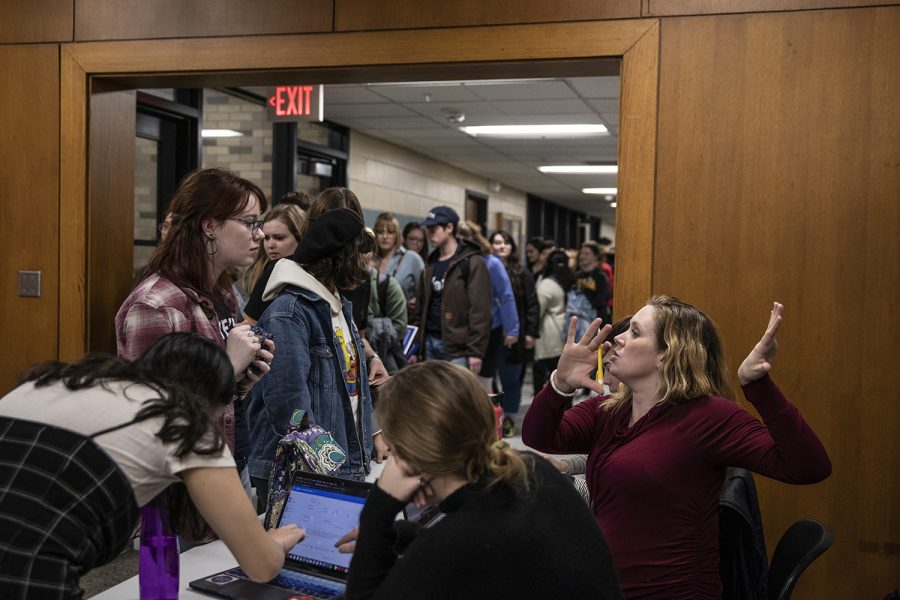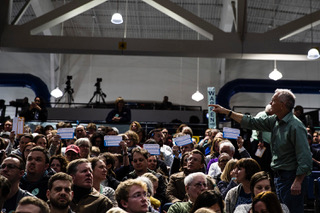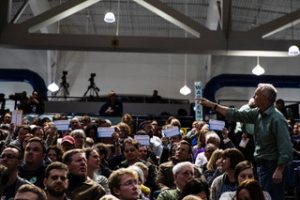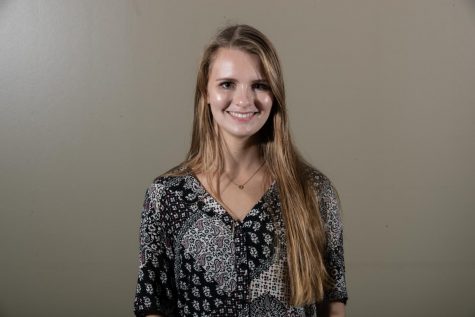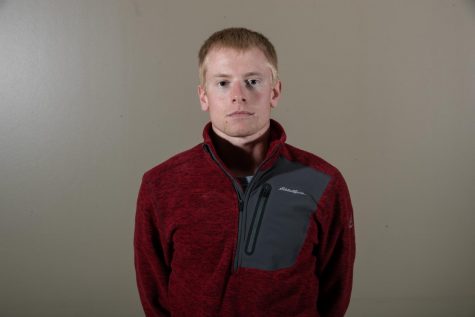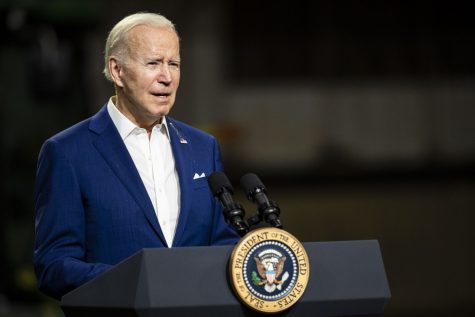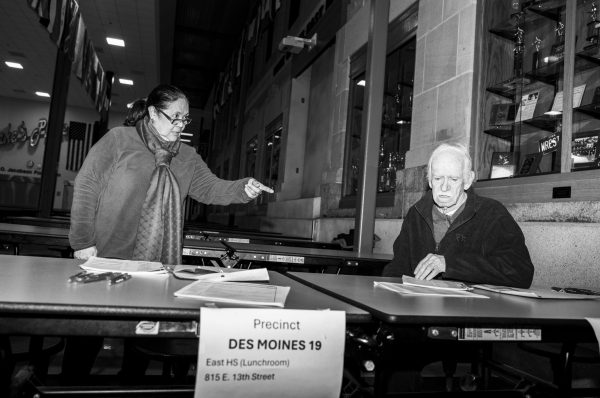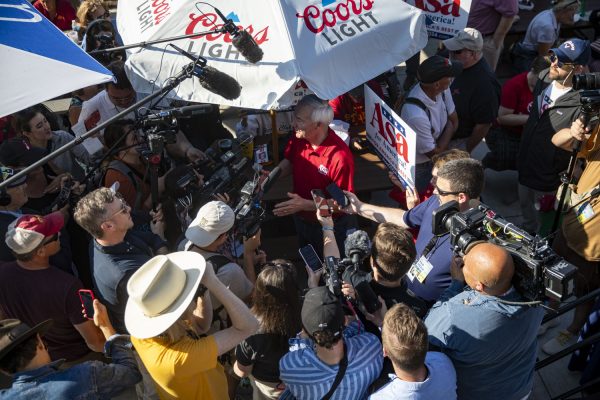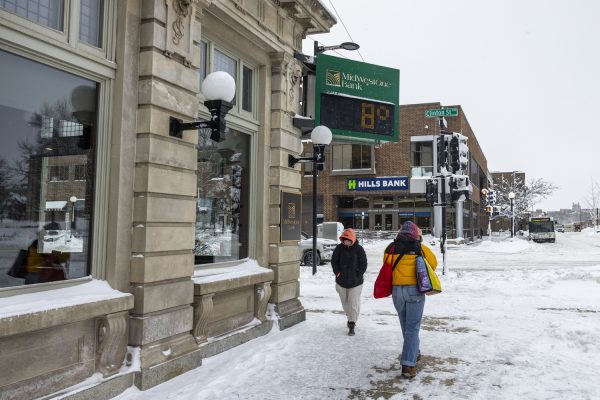First time satellite caucuses provide more accessibility to Iowa caucusgoers
The satellite caucus option arose for the first time in Iowa history, allowing more accessibility for the Democratic caucuses with 87 remote locations.
Volunteers speak with participants before a caucus at a satellite location at Phillips Hall on Monday. Those who could not make it to their designated precinct caucus location participated in the satellite site.
February 4, 2020
For the first time in the history of the state’s Democratic caucuses, Iowa implemented satellite caucuses — sites which local caucusgoers are lauding as bringing more accessibility into the process.
Amid concern from the Democratic National Committee about the accessibility of the Iowa caucuses, the Iowa Democratic Party recently created a satellite caucus option for caucusgoers, with the hope of increasing turnout for those who may otherwise have struggled to participate. As of press time Monday night, the party had not reported turnout numbers.
There were 87 satellite locations for Iowa Democrats, including 60 options in-state, 24 options out of state, and three international caucus locations placed in Paris, France; Glasgow, Scotland; and Tbilisi, Republic of Georgia.
Another change included additional start times for the satellite caucuses. For example, University of Iowa Hospitals and Clinics provided two satellite caucuses for patients and staff: one at 5:30 p.m. and one at 7:45 p.m.
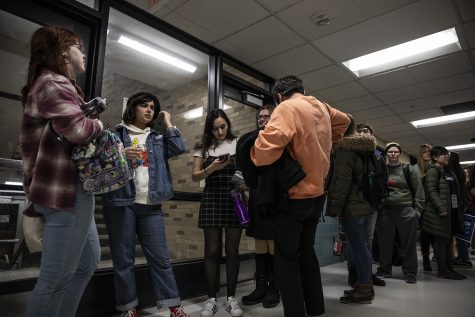
Caucus participants stand in line before a caucus at a satellite location at Phillips Hall on February 2, 2020. Those who could not make it to their caucus location participated in the satellite site.
Multiple retirement homes provided satellite caucuses and 24 new locations were provided for students on college campuses. A crowd of 318 people, mostly students, attended a satellite location in the UI’s Phillips Hall.
“My address sent me to [Iowa City] West High School and there was no way for me to get there because I was on campus,” said Phillips Hall caucusgoer and Des Moines native Yajaira Bolanos, 21. “Buses come, like, every hour and it was just very inconvenient. And then someone told me about this satellite caucus on campus at Phillips and I was like, ‘OK, I’ll go.’ I wouldn’t have gone [without the satellite caucus].”
In a typical caucus, an Iowan will travel to a precinct location, where a caucus will begin at 7 p.m. and can last for a few minutes or up to a few hours based on the number of attendees.
The Democratic National Committee expressed concern about the accessibility of precinct caucuses, because it can be difficult for people who may be elderly or disabled to physically travel to the precincts and could result in less overall turnout.
Issues with attendance that previously faced the caucuses included accessibility for caucusgoers who may work late, who may be college students, or who may be in hospitals and nursing homes.
UI students from varying counties expressed that the satellite-caucus option was more convenient given their busy schedules.
“We wanted to go home but it wouldn’t have worked out with morning classes,” said UI student and Johnston, Iowa native Maddie Petersen, 19.
Adults who attended the satellite caucus at Phillips Hall said that traditional caucus precincts are often not feasible options, because they have to travel from work.
“I was teaching on campus until 6:15 [p.m.],” said Marshall, Iowa native and UI lecturer Ashley Jennings, 33. “I would have had to go get my car and go drive to the caucus location that is closer to our house, and the likelihood of doing that within 45 minutes was slim, so this is facilitating my ability to caucus …”
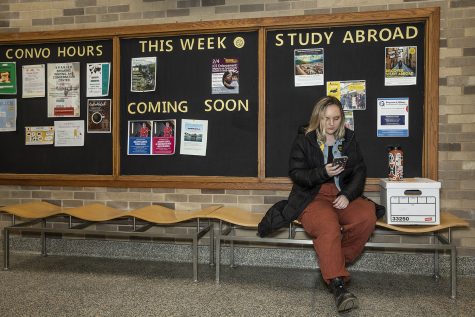
Pete Buttigieg Precinct Captain Caroline Price looks on her phone before a caucus at a satellite location at Phillips Hall on February 2, 2020. Those who could not make it to their caucus location participated in the satellite site.
Several students and attendants said they believed that attending a satellite caucus would help their vote count more.
UI student Anna Zinselmeier, 19, of Johnston, Iowa, said that she believed her vote would count more at a satellite caucus than a traditional precinct.
“A lot of us are from more rural areas and Iowa City is more of a progressive place,” Zinselmeier said. “So we just wanted to make sure our vote counted back home to give the candidates a boost back there.”
Each of Iowa’s four congressional districts reported an extra county to accommodate for their satellite-caucus results and one caucus county for all of the out-of-state caucus sites — meaning that the overall number of counties reporting totaled 104 instead of the usual 99.
The total number of delegates allocated to the satellite caucuses was based on the total turnout the satellite caucuses within each district, or turnout state-wide for the out-of-state and international sites. In total, the satellite caucuses were allowed up to 10 percent of the delegates.
John Bergstrom of Iowa City, 62, expressed gratitude for the satellite caucus at Phillips Hall and how it increased accessibility.
“I appreciate it because I could walk here from my home rather than drive to the official caucus site,” Bergstrom said, “which is why I am very pleased to have this opportunity.”



